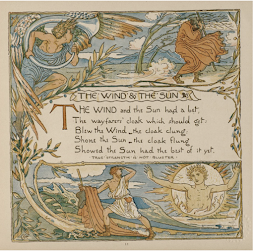Reading Notes: Aesop's Fables (Jacobs), Reading B
The stories that I chose to focus on in the second reading for this week is the stories about nature and inanimate objects from “The Fables of Aesop” by Joseph Jacobs (1894). These types of stories are unique and different to other stories I have read because the author gives inanimate objects a voice. Typically, in stories, I am used to people and even animals having a personality and voice, but I am not used to plants or the sun talking. In these stories, the inanimate objects are portrayed quite similarly to animals in other sections of “The Fables of Aesop” as they are able to communicate with others and have their own personality.
These stories are similar to the others in the way that they all have a hidden message. My personal favorite story in this section was about the belly and other parts of the body. In this story, I interpreted the meaning to be that sometimes you need all the pieces of a puzzle to make it work which I thought was a very powerful message. The style of the writing is short and to the point in delivering the message. The last thing that I noticed when reading these specific entries is that when the inanimate object has a personality, the word is capitalized in order to differentiate between the objects that aren’t “alive”.
(The Wind and the Sun by Walter Crane (1887) via UN-Textbook)




Comments
Post a Comment